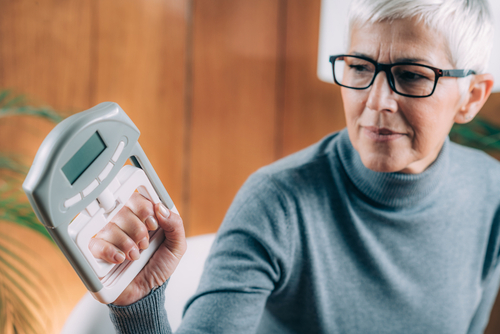Before experiencing hand or thumb arthritis, the use of the thumb is often taken for granted. Yet the thumb is one of the most useful joints, and we rely on it to complete simple, necessary tasks. Some of these tasks include getting dressed, turning doorknobs and opening jars. Those experiencing hand or thumb arthritis may suddenly become aware of the thumb’s immeasurable practicality due to the increased difficulty of completing such ordinary tasks.
Despite thumbs being one of nature’s most handy gifts, hand arthritis — including thumb arthritis — affects about 56% of men and 63% of women from the ages of 60 to 64. It has also been shown that the incidence of hand arthritis only increases after this age range.
Common symptoms of hand and thumb arthritis
Those who have thumb arthritis may experience symptoms of inflammation, deformity and pain around the thumb joint. Other symptoms may include decreased mobility and reduced range of motion within this joint. Progressive loss of function may also occur. This may be accompanied by a gradual impairment of your ability to complete everyday tasks.
Luckily, performing a thumb arthritis test can help to determine the severity of the arthritis and help determine the corresponding treatments that may slow down its progression and decrease symptoms.
What to expect during a hand or thumb arthritis test
A thumb arthritis test or assessment may involve:
- Grip strength test — Your grip may be tested by gripping a grip dynamometer. You will be sitting with your shoulders in a neutral position, elbows at a 90-degree angle and thumbs pointing upward. Your strength will be measured by how firmly you can grip the dynamometer with your other four fingers.
- Pinch strength test — Your pinch strength may be tested by pinching a pinch gauge. You will be sitting with your shoulders in a neutral position and elbows at a 90-degree angle. Your strength will be measured by how firmly you can press the gauge between your index finger and thumb.
- Pressure pain threshold test — Your threshold to pain may be measured by using an algometer: a device that applies pressure to the troubled area. In response to the applied pressure, you will be asked to let the physical therapist know the moment the pressure begins to cause pain.
- Questions from your physical therapist — Your physical therapist will likely ask you many questions as part of your thumb arthritis test. Some of these may require that you recall your general pain level and general ability to perform daily tasks. That’s why it may be helpful to write some notes about when and how much pain you feel throughout the day. Notes on which tasks you have trouble doing will also be helpful to both you and your physical therapist.
Find out how SOL Physical Therapy can treat your hand and/or thumb arthritis
Beyond a hand or thumb arthritis test lies many treatment options. SOL Physical Therapy offers individualized, cost-effective treatment plans. These plans can not only treat current hand or thumb arthritis symptoms but can also help prevent or slow the progression of your arthritis.
Contact our team today for more information about how we can treat your arthritis and its symptoms or to schedule an initial appointment.


